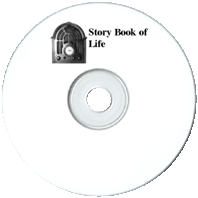

Storyteller Jim Ameche shares surprising and interesting ‘infotainment’ pieces from The Story Book of Life

30 old time radio show recordings
(total playtime 5 hours, 37 min)
available in the following formats:
1 MP3 CD
or
5 Audio CDs
Text on OTRCAT.com ©2001-2025 OTRCAT INC All Rights Reserved. Reproduction is prohibited.

A good deal of the misunderstanding comes down to the different ways post-WWII Americans and Europeans generally use their cars. Post-War America was overflowing with money, and living up to the promise of ‘a chicken in every pot, a car in every driveway’. Newly wealthy Americans needed those cars. Before and during the War there had been a great migration from farms to the cities, and now a new migration was leaving the congestion of the cities for the suburbs. A significant portion of each day would be spent traveling to and from home to work or shopping in the city. It would not be uncommon for someone to spend more time in his car than in his living room.
Post-War Europeans had far fewer cars and driving was an activity for the wealthy. Driving was an activity to be taken quite seriously, in part because it was a privilege and a responsibility to control a fine automobile. So was eating, for that matter, so European drivers found the notion of a drive-through restaurant mildly disgusting. Driving was too important to be distracted by food and drink, so why would you need cupholders? Some fine music might be nice on a long trip, but the jarring tunes and mindless chatter of American Radio as the TV age were simply too distracting for European tastes.
Since Americans were living a major portion of their lives in their cars, they not only needed cupholders so they could take a meal behind the wheel, in-car entertainment became vital. Although it seems unsafe to allow such a distraction behind the wheel, American drivers were covering enough distance that the distraction actually helps drivers to remain awake and alert. The in-dash radio began as an experiment by broadcast pioneer Lee de Forest at the 1904 St Louis World’s Fair. Radio was a $130 option in 1930 when a new Model A cost around $540. By the end of the Thirties, radios were becoming standard equipment with pushbutton controls improving safety by making the sets easier to tune.
As sponsor dollars began migrating to the small-screen format, dramas and variety programs began deserting the AM format, and the great radio networks began to shrink. Listenership began shifting to a "Drivetime" format of disk jockeys, popular music (in a marketable three-and-a-half-minute format), news on the half-hour, and short programs which were often syndicated to reach several markets.
The Story Book of Life hosted by Jim Ameche. The Ameche boys were born in Kenosha, Wisconsin (just up the road from Ray Bradbury and Jack Benny’s hometown, Waukegan, Illinois). Jim followed his big brother Don into vaudeville and eventually made it to Hollywood. Don Ameche became a popular leading man for 20th Century Fox as well as making a name for himself on Radio Row. He was the Master of Ceremonies on The Chase and Sanborn Hour when Edgar Bergen and Charlie McCarthy became stars, but left the program in early 1940 and kid-brother Jim got the job. Jim was also the original Jack Armstrong, the All-American Boy.
Syndication would be a good fit for programs like Story Book. The relatively short format (episodes ran about 12 minutes) had room at the beginning and end for local advertisement, and Story Book even had a pause in the middle for another ad. The stories would appeal to later fans of Paul Harvey’s The Rest of the Story which would go on the air in 1976. Each spot included two unrelated stories that would be somewhat familiar to history students, but listeners would be hooked until the end to find out whether the story was, in fact, the one they thought it was. This anticipation also makes The Story Book of Life classic "Drive Way Listening". A Drive Way show is one that is so interesting that when you reach home, you will sit with the car running to hear the end of the story!

Text on OTRCAT.com ©2001-2025 OTRCAT INC All Rights Reserved. Reproduction is prohibited.
You have reached the maximum number of votes for a unregistered user.
Please login or create a new account to continue...
You have reached the maximum number to down votes in this page.



Storybook of Life Disc A001
|
Add Audio CD to Cart - $5.00 |
Storybook of Life Disc A002
|
Add Audio CD to Cart - $5.00 |
Storybook of Life Disc A003
|
Add Audio CD to Cart - $5.00 |
Storybook of Life Disc A004
|
Add Audio CD to Cart - $5.00 |
Storybook of Life Disc A005
|
Add Audio CD to Cart - $5.00 |
Please wait...
COMMENTS
Roger Verified Purchase
Leave a comment